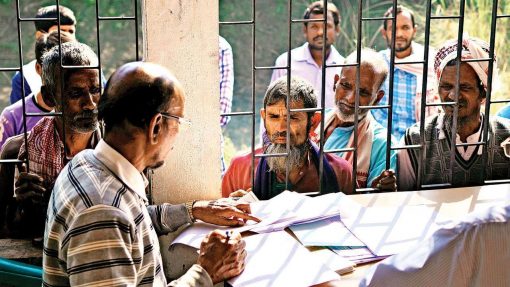Amitava Bandyopadhyay
The process of preparation of the National Register of Citizens or NRC may declare a true citizen an illegal immigrant or fail to detect a non-citizen. Erroneously classifying a bona fide citizen as illegal immigrant is called ‘false positive’ and failure to identify a non-citizen is called ‘false negative’. While false negatives defeat the very purpose of the exercise, false positives are traumatic for genuine citizens and its high incidence creates an atmosphere of mistrust.
The Case of Assam
In Assam, about 3.3 crore persons applied for inclusion in the NRC. The draft NRC rejected about 40 lakh applications. However, after subsequent claims and scrutiny, 18 lakh applications were rejected. Apart from the exclusions in the draft NRC, objections were raised against the inclusion of about two lakh persons. On further scrutiny, about one lakh of these persons were excluded. Thus, the final list published on August 31, 2019 excluded about 19 lakh (19,06,657 to be exact) people, leading to the following estimates of false positives and negatives.
- False Positives: The draft NRC initially rejected about 40 lakh applications, whereas 18 lakh were finally excluded. Thus about 22 lakh applicants out of 3.3 crores were wrongly rejected at the draft stage leading to 6.8% false positives.
- False Negatives: The initial process of updating NRC failed to detect about one lakh or about three out of 1,000 non-citizens leading to 0.3% false negatives. Importantly, about six out of 1,000 or 0.6% of the inclusions were challenged.
The estimated rates of 6.8% and 0.3% for false positives and negatives compare favourably with published rates of different medical tests. Thus, these error rates are already low, and consequently any further reduction would be difficult.
Further, the rate of false negatives is close to zero. Thus, improvement, if any, needs to be targeted for false positives only. However, reduction of rate of false positives would require loosening acceptance norms. This is likely to increase rate of false negatives, defeating the very purpose of the exercise.
False Positives & Negatives for Pan-India NRC
The actual rate of errors that would be achieved in case of pan-India implementation is unknown. In Assam, the rates of false positives and negatives were 6.8% and 0.3%, respectively. Since these rates are fairly low and compare favourably with standard medical tests, it would be risky to assume lower rates of error for a larger pan-India implementation unless backed by concrete plans.
The likely consequences of a pan-India implementation, therefore, are:
- About 11 Crore Applications are Likely to be Rejected Initially: The initial rate of rejection of applications equals the rate of false positives plus the proportion of illegal immigrants. Thus, the presence of 2% illegal immigrants would lead to an initial rejection of 8.8% applications. Assuming 125 crore applicants, about 11 crore, would be excluded.
In case the percentage of illegal immigrants is 1%, about 9.75 crore applications would be rejected. If the actual proportion of illegal immigrants is 3%, the initial rejection would be a whopping 12.25 crore.
Naturally, several crores of claims are likely to be filed putting a severe burden on the review system. Further, every direct rejection would almost certainly impact other family members and the total number impacted is likely to be far more than the direct rejections.
- 88% of the Initial Rejections May be Wrong: If the true proportion of illegal immigrants is 1%, the number of rejections should be about 1.25 crore. However, it would be 9.75 crore due to false positives. Thus, 88 out of every 100 initial rejections would be unjust. Even if the proportion of illegal immigrants is 3%, a good 70% of the initial rejections would be unjust. Such a high rate of unjust rejections is likely to shake the faith of the common citizens on the state system.
- Resource Requirement and Timelines: The NRC update in Assam was carried out for 3.3 crore applicants. The process required over four years and involved about 52,000 state government officials. The 3.3 crore applications could be initially scrutinised in 35 months but settlement of 38 lakh claims and objections took 13 months. Thus, the rate of settlement of objections and claims was less than 1/3rd of the rate of original scrutiny.
Under these circumstances, a pan-India implementation involving 125 crore applications, over nine crore claims and about 75 lakh objections against inclusions would be a project managers’ nightmare. Without meticulous planning and control such projects are certain to lead to colossal cost and time overruns as evidenced in many other large projects.
A Risky and Costly Affair
A pan-India implementation of NRC is risky and likely to be a costly affair. About 11 crore applicants are likely to be rejected initially. Over 80% of the initial exclusions are likely to be unjust. Thus, over eight crore genuine citizens and many more family members are likely to have a traumatic experience that may last well over one year.
Further, the large number of unjustified exclusions would surely have an adverse impact on the faith of the ordinary citizen on the fairness of the state system. In addition, several million objections may be filed leading to an atmosphere of extreme mistrust among citizens.
The huge complexity of the project is very likely to lead to inordinate delays. Apart from being costly, delay in this project adds to the personal trauma of crores of excluded genuine citizens.
Lastly, the entire exercise would require the services of several million employees at a great cost to the exchequer. Employing and managing such a large pool of manpower poses a major challenge and may turn out to be the source of much delay and errors.
(The writer is Senior Technical Officer, Statistical Quality Control & Operations Research Division, Indian Statistical Institute, Kolkata.)




